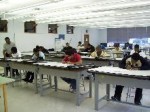
An Unidentified Flying Object was recently seen hovering around the Grambling State University campus. Onlookers tried to determine what it was and where it came from.
Upon closer examination, it was determined that the UFO was a mechanical radio-controlled flying device, designed and constructed by John Frazier’s Engineering Graphics classes.
Frazier, a faculty member in the Engineering Technology Department, conceived the idea of the special project to help students understand the mechanical engineering and drafting and design process in real-world, functional applications.
“I chose the flying device because it incorporates numerous components and principles used in the area of drafting and design engineering technology,” Frazier said.Frazier said, in the beginning of the conceptualization stage, he discussed with Dr. Olusegun Adeyemi, head of the Engineering Technology Department, the idea of providing students enrolled in the engineering graphics classes some hands-on training in addition to the theory taught in the classroom. He and Dr. Adeyemi agreed on a special project for the students that would include designing, drawing and constructing the flying device. This type of project helps to prepare students for the profession.
To assist the students in gaining an understanding of the scope of the special project, Dr. Adeyemi and Dr. Edwin Thomas, coordinator of Drafting and Design Engineering Technology, assisted Frazier in building a prototype of the flying device.
Although similar styles of the flying device exist, Frazier and his students made modifications in their design process to create their unique craft. Using drafting techniques, students were required to draw the flying device, including all the components and then construct the device based on the details in their drawing.
The flying device was constructed of foam and uses basics of engineering and aerodynamics. The final stage of the project involved testing the students’ work to see if the craft would fly.
“The project gave me greater interest in the engineering field,” said John Foster of Shreveport. “Hands-on activities increase the amount of information learned.”
Steven R. Hill of Minden explained why the project was important to him. “This entire process has motivated me to stay in the engineering field,” he said. “I know for a fact this is the career path for me. The whole idea of designing a project and watching it come to life is an amazing experience.”
Frazier said the project will have other benefits.
“The device will be placed on display in the Engineering Technology Department and used periodically in demonstrations to recruit students for the university and the department,” Frazier said. “Hopefully, it will encourage and motivate students to enter the engineering technology profession.”
When asked if there were plans for other hands-on projects, Frazier said, “Yes, we have plans for other projects. This was a pilot project to determine students’ interest in participating in a hands-on design process that would allow them to gain experience and a broader understanding of the design process used in Engineering Technology.”
Flight day arrived on Tuesday, Frazier, and the students, accompanied by Adeyemi, Thomas and others, saw their efforts come to life with the successful flight of the class project – the UFO sighted on GSU’s campus.
“Many students drop out of engineering and engineering technology programs before they ever experience what the profession is all about,” Dr. Adeyemi said. “The students come to their conclusion based on their experience in math and science courses, and decide that engineering is not for them.”
Adeyemi said that while the role of math and science in engineering cannot be discounted there is also the “art” of engineering, which traditionally does not get much emphasis, especially early in the engineering and engineering technology programs. It is the practice of this art that separates an engineer from a scientist, the department head said.
“Implementing a project-based approach to engineering technology education early in our curriculums will permit students the opportunity to experience this aspect of the profession right from their first year of matriculation,” Dr. Adeyemi said.
“I felt that this was a great experience for freshmen in the engineering field,” said David Harbor of Carrollton, Texas. “That way we have an idea what the field of engineering is about.”
“The project was exciting and it helped me realize I am in the right field,” Joan Rachel Nkiriki said. “Working on this project also helped me see that as long as I am willing to learn and put my brain to work, I can build anything and become a billionaire.
